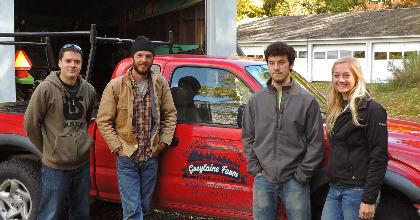Pigs sometimes escape their fencing at Greylaine Farm in Shelburne, Vermont. When they do, farmer Michael Kirk is quick to herd them back in. “Those snouts can certainly find their share of trouble,” he says with a laugh.
Pasture-raising lamb, pork, and laying hens keep this 2009 UVM graduate busy, but he’s had some extra help this year from his alma mater in solving another problem facing small farmers: finding a small-scale egg-washing machine that will prepare his farm’s eggs for market.
Because eggs get dirty on the farm, Kirk was looking for a machine that could handle his hens’ daily production of 100 eggs, yet scale up to about 3,000 eggs per day as his farm expands. But current devices are designed for much larger productions, he notes.
“Most egg-washing machines need an entire barn to operate in because they are about 20 feet long. And they take two people to operate,” Kirk says.
Having two farmers running a machine when problems arise – for instance, when the pigs become ornery and need attention – isn’t convenient. The other option is the time-consuming practice of hand washing. “I wanted something better than what is out there, so I called UVM,” he says.
Kirk’s challenge was taken up by a team of engineering students at the College of Engineering and Mathematical Sciences as their senior Capstone project, which is a team-based design and engineering project required of the school’s engineering students.
For Matthew Lane, a CEMS senior mechanical engineering student who is working on the egg-washing device with fellow students Christina Millar and Henry Duncan, their goal was clear: to develop a prototype egg washing device that would be compact, farmer-friendly and conserve water.
“Egg washers can be a water-intensive operation,” Kirk notes. “I didn’t want that. I would rather water be used for the essential soil and grass on my farm.”
Water is used as a universal solvent in most washing systems, notes extension assistant professor of Agricultural Engineering Chris Callahan, who serves as a student advisor on the project and whose work focuses on the application of engineering practices to food systems.
The project not only solves a design problem, but represents just one of the new challenges arising from the growth of the local food movement, which has spurred demand for locally produced foods such as eggs.
Delivering safe, clean food to consumers’ tables often relies on leveraging technology in clever ways, Callahan points out. “Food can be a dirty business, and we tend to be disconnected from that as consumers,” he says. “This is an example of where some mechanization will allow smaller scale egg producers to focus on increased volume and increased profitability without sacrificing cleanliness of the eggs and food safety.”
The students turned to scrap materials, motors and circuit boards for their materials. The machine is far from a traditional piece of farming equipment: the initial controls were made with an old Nintendo video game controller. Designed to be portable, the machine is only 12 inches high and 25 inches long, and can sit on a countertop, similar to a kitchen appliance.
The students’ prototype design uses relatively little water and is similar to a low-flow showerhead, while brushes handle most of the work. The amount of water used can be adjusted for each batch of eggs.
The process helped Duncan and the other students learn about the aspects of working on a team. “It has also taught me what I think are going to be two very important skills, time management and communicating effectively,” he adds.
For instance, the students came up with several methods for moving the eggs through the machine and using the brushes for cleaning, but “a lot of unforeseen conflicts” arose when the time came to put it all together, Duncan notes. “Our biggest success has been creating a working prototype months ahead of schedule,” he says.
The students’ aim is that the final product will be replicable for other farmers.
“The biggest challenge we’ve had is selecting real world parts that are easily obtainable,” Lane says. “One of the goals of the machine is that it is easily replicable so we considered that in the part selections.”
As for Kirk, he says the machine could make a real difference beyond Greylaine Farm. He notes, “What this does is take learning beyond classroom walls. This is something that could create real impact for farms.”
This is a glimps at one of the projects featured in the 2015 Engineering Design Night which will take place on Tuesday April 28th from 4:30-7PM in the Maple Ballroom in the Davis Center. Click here to learn more.
This article originally appeared in the Spring 2015 SUMMIT.
